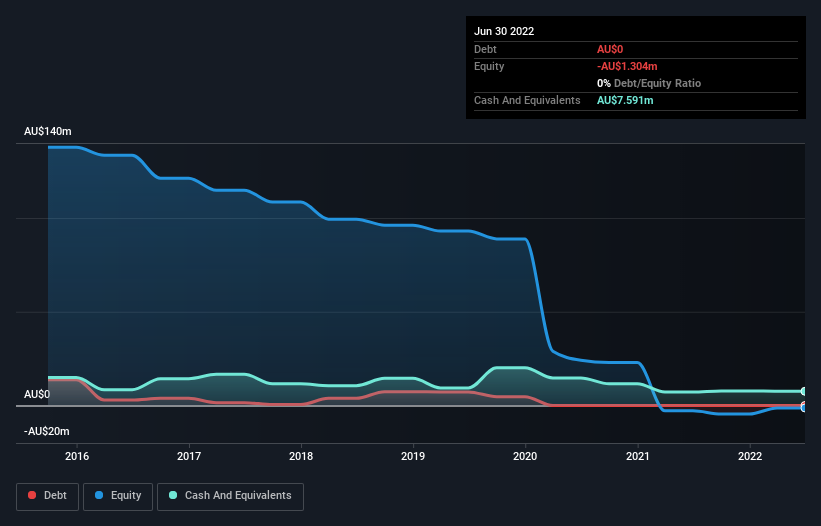We Think Matrix Composites & Engineering (ASX:MCE) Can Afford To Drive Business Growth
Just because a business does not make any money, does not mean that the stock will go down. For example, although Amazon.com made losses for many years after listing, if you had bought and held the shares since 1999, you would have made a fortune. Nonetheless, only a fool would ignore the risk that a loss making company burns through its cash too quickly.
So should Matrix Composites & Engineering (ASX:MCE) shareholders be worried about its cash burn? For the purpose of this article, we'll define cash burn as the amount of cash the company is spending each year to fund its growth (also called its negative free cash flow). Let's start with an examination of the business' cash, relative to its cash burn.
See our latest analysis for Matrix Composites & Engineering
Does Matrix Composites & Engineering Have A Long Cash Runway?
You can calculate a company's cash runway by dividing the amount of cash it has by the rate at which it is spending that cash. In June 2022, Matrix Composites & Engineering had AU$7.6m in cash, and was debt-free. In the last year, its cash burn was AU$5.7m. So it had a cash runway of approximately 16 months from June 2022. While that cash runway isn't too concerning, sensible holders would be peering into the distance, and considering what happens if the company runs out of cash. The image below shows how its cash balance has been changing over the last few years.
How Well Is Matrix Composites & Engineering Growing?
Matrix Composites & Engineering reduced its cash burn by 20% during the last year, which points to some degree of discipline. Having said that, the revenue growth of 62% was considerably more inspiring. It seems to be growing nicely. Of course, we've only taken a quick look at the stock's growth metrics, here. You can take a look at how Matrix Composites & Engineering is growing revenue over time by checking this visualization of past revenue growth.
How Hard Would It Be For Matrix Composites & Engineering To Raise More Cash For Growth?
Matrix Composites & Engineering seems to be in a fairly good position, in terms of cash burn, but we still think it's worthwhile considering how easily it could raise more money if it wanted to. Generally speaking, a listed business can raise new cash through issuing shares or taking on debt. Many companies end up issuing new shares to fund future growth. By comparing a company's annual cash burn to its total market capitalisation, we can estimate roughly how many shares it would have to issue in order to run the company for another year (at the same burn rate).
Matrix Composites & Engineering has a market capitalisation of AU$34m and burnt through AU$5.7m last year, which is 17% of the company's market value. Given that situation, it's fair to say the company wouldn't have much trouble raising more cash for growth, but shareholders would be somewhat diluted.
Is Matrix Composites & Engineering's Cash Burn A Worry?
The good news is that in our view Matrix Composites & Engineering's cash burn situation gives shareholders real reason for optimism. One the one hand we have its solid cash burn reduction, while on the other it can also boast very strong revenue growth. While we're the kind of investors who are always a bit concerned about the risks involved with cash burning companies, the metrics we have discussed in this article leave us relatively comfortable about Matrix Composites & Engineering's situation. On another note, we conducted an in-depth investigation of the company, and identified 4 warning signs for Matrix Composites & Engineering (2 are significant!) that you should be aware of before investing here.
Of course, you might find a fantastic investment by looking elsewhere. So take a peek at this free list of interesting companies, and this list of stocks growth stocks (according to analyst forecasts)
Have feedback on this article? Concerned about the content? Get in touch with us directly. Alternatively, email editorial-team (at) simplywallst.com.
This article by Simply Wall St is general in nature. We provide commentary based on historical data and analyst forecasts only using an unbiased methodology and our articles are not intended to be financial advice. It does not constitute a recommendation to buy or sell any stock, and does not take account of your objectives, or your financial situation. We aim to bring you long-term focused analysis driven by fundamental data. Note that our analysis may not factor in the latest price-sensitive company announcements or qualitative material. Simply Wall St has no position in any stocks mentioned.
Join A Paid User Research Session
You’ll receive a US$30 Amazon Gift card for 1 hour of your time while helping us build better investing tools for the individual investors like yourself. Sign up here

 Yahoo Movies
Yahoo Movies 
